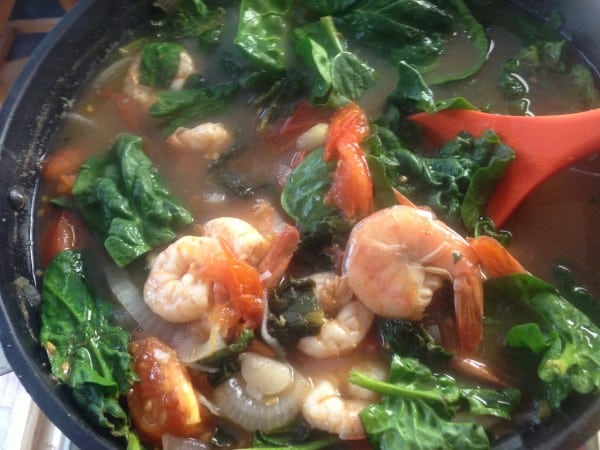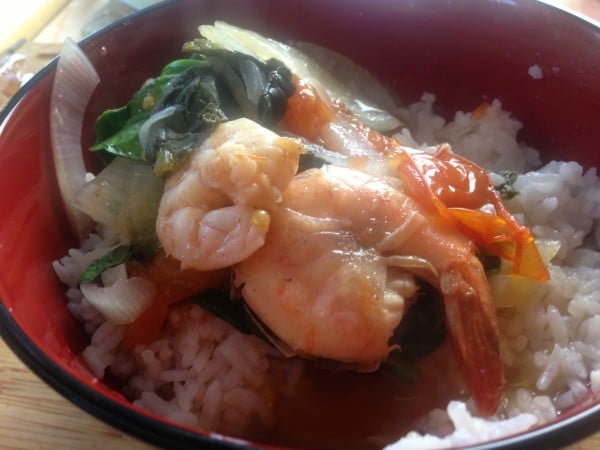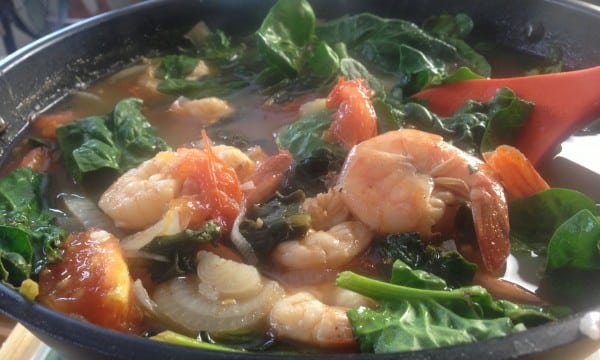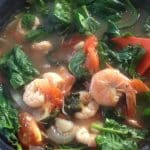Sinigang na Hipon – Tamarind Soup with Shrimps and Vegetables
As an Amazon Associate and member of other affiliate programs, I earn from qualifying purchases.
If your face puckers up after the first sip of the Filipino sinigang, then the sour broth is really good, according to my Kapampangan friends. “My favorite food is Sinigang na Hipon and I cook it the Kapampangan way,” said Mary Jane Alvero, my fellow awardee at the FWN Global 100.
I thought of Mary Jane when I cooked Sinigang na Hipon – Tamarind Soup with Shrimps and Vegetables last week because my feature story on her “Dauntless in Dubai” just published in PositivelyFilipino.com. While interviewing Jane and hearing her compelling life story, I found out her mom was from Pampanga, a province known for its culinary heritage.
Sinigang (say ‘see-knee-gangh’) is the traditional Filipino soup that is flavored with souring agents like boiled tamarind mashed into a thick pulp and added to a simmering broth. The result is like a lilting tune – the broth starts out clear looking, yet the sour and tangy flavors hit a high note after it slides down your throat. It is a marvelous dish to make all year round, any day of the week or where ever you live in the world. The tangy broth poured on a mound of rice is one of the most comforting meals ever.
When Jane told me she cooked it the way I was used to, the Kapampangan way (of Pampanga, a province north of Manila) I knew exactly what she meant.
“Kapampangan food is always slow cooking,” said Marcos Calo Medina, a good culinary friend who goes three generations deep in Pampango heritage recipes. I agree with Marcos. My mom taught me “Slow fire. Slow cooking always.” This was one of the first lessons I learned when I was tall enough to reach the kitchen counter and help with dinner.
One night last week, in the middle of a huge snow storm here in the east coast I wanted the comfort of sour-savory Sinigang for dinner. But I was going to do it with shrimps instead of the usual pork belly chunks. My vegetable bin was not quite complete, so I forgave myself because the roads were just too icy to get into the car for a last minute trip to the grocery. Instead, I made do with what I had : fresh jumbo shrimps, a block of tamarind concentrate, tomatoes, onions, fresh spinach and the addition of calamansi (Filipino lime) to add as a souring agent.
The easiest part of this dish was boiling the broth with the tamarind concentrate. Once I had that all worked up in a slow simmer, the fragrance from the tangy tamarind mixed with the soup stock and rice wash was a good backdrop to everything else I poured into the soup stockpot.
Can you see my face all puckered up now? That’s how Sinigang always gets my face all wrinkled and crinkly. A true sign this must be good.
I dedicate this Shrimp Sinigang I cooked to my fellow awardee, Mary Jane Alvero. I met Jane when we both received our awards from the Filipina Women’s Network (San Francisco, CA) last October. Be inspired by this Filipina’s life and career. Read my article on her “Dauntless in Dubai” via PositivelyFilipino.com.
Sinigang na Hipon - Tamarind Soup with Shrimps and Vegetables
Equipment
- Large Stock pot or Dutch Oven: 10 to 12 quarts
Ingredients
- 1 pound large-sized fresh shrimps about 2 cups; peeled, heads and tails removed
- 1/2 cup calamansi juice (or use lemon) divided use 1/4 to marinate shrimps, the rest for broth; Calamansi, the Filipino lime from Asian markets
- 8 to 10 cups water or rice wash
- 1 whole large onion chopped
- 2 whole large tomatoes chopped
- 1 inch piece solid tamarind (from the block) diluted in 1/4 cup warm water
- 3 cups fresh baby spinach or use kangkong (water spinach)
- 2 Tablespoons patis (fish sauce)
- 1 teaspoon salt
- 1 teaspoon ground black pepper
- for serving: steamed rice
Instructions
- Prepare and marinate shrimps: Peel and wash shrimps. Marinate with calamansi juice (or use lemon). Set aside in the refrigerator for 30 minutes till ready to add to broth.
- To cook the sinigang broth: In a large stockpot, pour rice wash or ‘hugas bigas’ (or water). Add the calamansi juice, onions, tomatoes and tamarind diluted in 1/4 cup warm water. Bring this to a boil then lower heat to medium for a slow simmer. Cover and simmer for about 15 minutes for tart tamarind flavor to set.
- Add the shrimps and patis (fish sauce). The shrimps will turn from grey to a light orange color which means it is cooked. This should take about 8 to 10 minutes.
- Add the spinach and cook for 3 minutes more till the leaves wilt. Season with salt and black pepper powder. Serve with steamed rice and a dipping sauce of patis (fish sauce) on the side.
- Cook’s comments: Other vegetables may be added to this Sinigang like sitaw (long green beans), radish, gabi (taro), kangkong (water spinach). Feel free to use a regular fillet of fish for this one, too. Add more soup stock or water if needed. And if you want a zing to the dish, add 1 or 2 long finger chilies or what Filipinos call ‘siling mahaba' and boil it with the sinigang broth.
Hello, Friends! All the images and content here are COPYRIGHT PROTECTED. This means BY LAW you are NOT allowed to use my photos or content on your website without my permission. If you want to republish this recipe, please re-write it in your own words and simply link back to this blog to give proper attribution. It’s the legal thing to do. Thank you.
Nutrition
Notes on Nutrition: The nutrition data for this recipe includes the full amount of the marinade ingredients. The actual amount of the marinade consumed will vary. The nutrition information provided is an estimate and will vary based on cooking methods and specific brands of ingredients used.
Did you like this recipe? I have more classic recipes inspired by my late mother’s cooking in my popular cookbook: My Mother’s Philippine Recipes. If you’re learning how to cook Filipino food or a fan of Philippine cuisine, buy my cookbooks and books on Amazon.com sold worldwide in paperback and Kindle format.
Copyright Notice: Hello, Friends! Please DO NOT LIFT OR PLAGIARIZE my original recipe, stories, photos or videos. All the images and content on this blog are COPYRIGHT PROTECTED and owned by my media company Besa-Quirino LLC. This means BY LAW you are NOT allowed to copy, scrape, lift, frame, plagiarize or use my photos, essays, stories and recipe content on your websites, books, films, television shows, videos, without my permission. If you wish to republish this recipe or content on media outlets mentioned above, please ASK MY PERMISSION, or re-write it in your own words and link back to my blog AsianInAmericaMag.com to give proper attribution. It is the legal thing to do. Thank you. Email me at [email protected]












This is a very new dish that I’ve never tasted before, but it’s interesting how comforting it looks and making me feel at home… Well, your dishes are always very homey and nice. Your children must miss your home cooking very much. I would, if I grow up eating your dishes… Looks scrumptiouos!
Thanks, Nami. This is a great comfort meal any day, any where in the world for Filipinos. Glad you came by.
Oh my goodness I just want to dive right into that bowl. I love soup, especially those with bright flavors such as you have here. I don’t keep tamarind paste on hand but I’m pretty sure I can find it. Is Filipino fish sauce much different from Vietnamese?
Hi Domenica. What a treat to have you visit my blog. Yes, Filipino fish sauce “patis” is similar to the Vietnamese. If you have it do try this one. Tamarind paste is so versatile. You can add it to other ingredients, say to coconut, and have a fantastic flavor. Thanks for the blog-love!